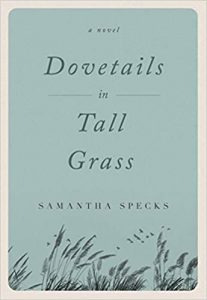Writing Historical Fiction with Debut Novelist Samantha Specks
 Inspired by the true story of the thirty-eight Dakota-Sioux men hanged in Minnesota in 1862―the largest mass execution in US history―Dovetails in Tall Grass is a tale of two young women connected by the fate of one man.
Inspired by the true story of the thirty-eight Dakota-Sioux men hanged in Minnesota in 1862―the largest mass execution in US history―Dovetails in Tall Grass is a tale of two young women connected by the fate of one man.
Writing Historical Fiction with debut novelist Samantha Specks
Though my novel is about events in 1862, for me the story started on Christmas 2005. A bitter wind blew snow over a country road. I was a high-schooler, cozy riding in my parents’ Suburban making the final turn to my grandparents’ home, when my blue eyes spotted something new. Headlights illuminated shapes moving across the darkening horizon. A group of men on horseback.
Curious, I asked my parents why people were riding in the cold. My mother explained: “They’re Dakota who are marching to show they haven’t forgotten what happened here long ago.” And I’ve spent the last 15 years of my life learning what they haven’t forgotten.
It was that cold night on the frozen Minnesota prairie when the first seeds of the Dovetails story were planted in my heart. The men who I crossed paths with were the Dakota 38+2 Riders. To commemorate the US-Dakota War anniversary and promote reconciliation, this group still rides every December from Lower Brule, South Dakota to the site of the mass hangings in Mankato, Minnesota. Their journey inspired the girl I was and the woman, and author, I am today.
Writing Dovetails in Tall Grass
Dovetails grew its way through the cracks in my life. In hindsight, I can see how there was space for that, as my career path was meandering; I previously worked in sports broadcast journalism and as a therapist. It was during my graduate studies in 2011 that I began diving deeper into my interest in the US-Dakota War; somewhere amidst the academic research and my personal interest, I began to interpret the history with a lens for story, through the perspective of two women.
Still, years and a career passed by. It wasn’t until 2017, once my husband and I had moved from Minnesota to Texas that he encouraged me, “why don’t you finally write that book idea you always talk about?” Story had pushed its way through, grown too big to ignore. A nudge and a new beginning in the Lone Star State were what I needed to give it the time and space it deserved.
Once the moving boxes were unpacked, I had to figure out how to write a book. I didn’t even own a laptop, so a visit to the Apple store was a starting point. My mind was overflowing with ideas. A massive roll of artist’s paper seemed like a good purchase as well. Then I spent six months doing intensive research. There was no information about the US-Dakota War that was too big or too small.
My brain wanted it all: scholarly articles, old texts from libraries that hadn’t been checked out for years, or page 7 of comments on Minnesota History message boards. It was time well spent. Once I really knew the history inside and out, I outlined. I unrolled that giant scroll of artists paper and made detailed historical timelines and abstract conceptual character boards.
Hours upon hours, I sat on my hardwood floor surrounded by torn sheets of paper, stacks of texts, random pages flagged in open books, and my keyboard home row already worn from the constant clickty-clack of notetaking. After a few months, I sat back and looked at the chaos of a story around me. I let myself feel it. It wasn’t in the past; it overwhelmed my heart now. This war was complex. Ugly. Unresolved. This time in history mattered so much to me.
I knew it, I felt it, I had it. It was time to write.
I took a deep breath, let it out, and started typing. Most mornings, I’d head to a Starbucks with a singular goal of getting the fictional characters of 1862 living in my mind onto a Microsoft Word document. Some days I felt hopeful the writing was taking the shape of a story, but most days I felt like an imposter. I was a first timer, and it was excruciating. To me, my pages were rough, messy, and imperfect.
After a morning of writing, I’d stop at Brazos Bookstore to look at the historical fiction section. Beautiful covers, stunning prose. How did writers do this? Mornings at the coffeeshop began to feel dreadful. When I opened my document, those first draft pages felt like I was catching a glimpse of myself midway through a dental procedure. Mouth open bizarrely wide, water and bits of whatnot spraying about, drills zinging and polishers whooshing too loudly in my ears.
The world was already full of brilliant authors with dazzling work who smiled perfectly from the shelves. Real, flawless, writing like that was something my messy pages could never be. When I started working with an editor, my insecurity only worsened. I couldn’t look at myself. My stomach flipped with anxiety each time I saw my editor’s name pop up in my inbox. Despite her positivity and encouragement, the comments, deletions, and suggestions throughout my pages flagged my failure. A professional was making it clear that I didn’t have the writing chops. Who was I kidding?
One day, probably while I was avoiding writing and in some rabbit hole of research, I stumbled upon an image of JK Rowling’s edited Harry Potter pages. They were marked top to bottom, Xs over massive blocks of her writing. Wait… what? Rowling’s edits were messy?! On my next visit to the bookstore, the shelves looked different to me. The titles were still awe-inspiring. But the authors’ names were superhuman in a new way… they didn’t get here because they wrote a perfect first draft. They got here because they pushed through every comment, suggestion, flag, cut paragraphs, deleted precious words time and time again. The process was ugly. Ugly and necessary.
My therapist brain flipped on. An editor’s feedback would be exposure therapy for me. Bit by bit, I’d face and feel the anxiety of looking at my words. And in that discomfort of exposure, bit by bit, I’d get stronger. I needed to get okay with the ‘ugly and necessary’. Shame dissolved in the light of that truth.
Before long, I was refreshing my inbox, hoping to see my editor’s name pop up. I craved feedback. I didn’t need my writing to be the Harry Potter; I needed it to be Rowling’s marked up pages. And with that shift in my thinking, the words poured out of me.
I got down to it and I wrote a book.
After a handful of years writing, I don’t think of myself as a “writer”. I think of myself as someone who is just lucky enough to tap into compelling ideas when I learn about significant times in history. After I’ve spent time in the trenches of research, the fictional story is something totally outside of myself that I just happen to be able to see.
The more I study the fascinating dynamics of our past (cough cough *present*), the more fire lights within me and illuminates just what complexities would play out in a story arc. If I can get my fingers to type fast enough, the actual writing feels like grabbing the ideas/feelings/characters invisibly floating beyond my mind and sticking them onto the physical page. If I write well enough, at the end of my work the fire will spread to a reader turning the pages of a meaningful story playing out on our vibrant and vivid past.
Hopes for a Reader
After finishing Dovetails in Tall Grass, these are my hopes for a reader…
I hope a reader sets the book down and thinks, “Wow, I can’t believe I didn’t know about this time in history before…” and they instantly google “Chief Little Crow” or “Dakota 38+2 Riders” — and maybe even search for “Emma Heard” or “Oenikika” because these fictional characters feel so real, they must be part of the actual history.
I hope this is a novel that makes a reader look forward to her book club meeting – that it brings out lively, engaging, dynamic conversation in a group. And that she chooses to chime in a few more times than she usually does in that discussion.
And finally, at the end of the day, I hope a reader remembers Dovetails in Tall Grass a novel that made her think, feel, and question. When someone asks her, “Have you read any good books lately?” She recommends it; not just because she liked the story but because she wants others to know how much the US-Dakota War of 1862 mattered.
—
ABOUT THE AUTHOR:
Samantha Specks is a licensed independent clinical social worker. She and her husband live in Houston with their baby (Pippa) and fur baby (Charlie). When not in Texas, they enjoy spending time on the lakes of Minnesota and in the mountains of the Roaring Fork Valley in Colorado. Dovetails in Tall Grass is Samantha’s debut novel. Currently, she is writing Dovetails of a River, which is set at the Battle of the Little Bighorn. For more information, please visit https://samanthaspecks.com
DOVETAILS IN TALL GRASS
 As war overtakes the frontier, Emma’s family farmstead is attacked by Dakota-Sioux warriors; on that same prairie, Oenikika desperately tries to hold on to her calling as a healer and follow the orders of her father, Chief Little Crow. When the war is over and revenge-fueled war trials begin, each young woman is faced with an impossible choice. In a swiftly changing world, both Emma and Oenikika must look deep within and fight for the truth of their convictions—even as horror and injustice unfolds all around them.
As war overtakes the frontier, Emma’s family farmstead is attacked by Dakota-Sioux warriors; on that same prairie, Oenikika desperately tries to hold on to her calling as a healer and follow the orders of her father, Chief Little Crow. When the war is over and revenge-fueled war trials begin, each young woman is faced with an impossible choice. In a swiftly changing world, both Emma and Oenikika must look deep within and fight for the truth of their convictions—even as horror and injustice unfolds all around them.
Inspired by the true story of the thirty-eight Dakota-Sioux men hanged in Minnesota in 1862—the largest mass execution in US history—Dovetails in Tall Grass is a powerful tale of two young women connected by the fate of one man.
BUY HERE
Category: Contemporary Women Writers, How To and Tips
























